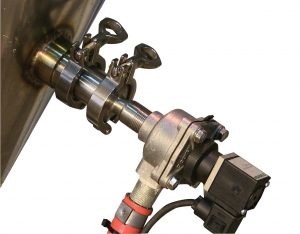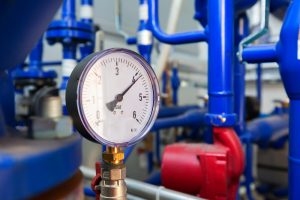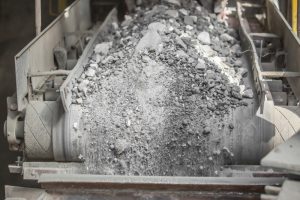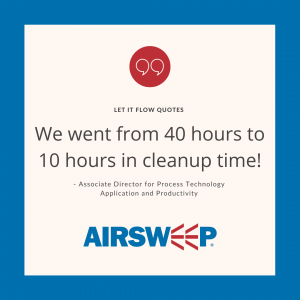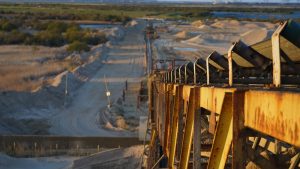AirSweep Straight Shooter FAQs
AirSweep is one of the most powerful pneumatic flow aids in the industry. It can solve tough flow problems that even fluidizers, vibrators, and air cannons cannot. The secret of AirSweep lies in its nozzle. It directs high-pressure, high volume, bursts of compressed air or inert gas along the inside walls of process equipment or […]
See PostUSDA-Accepted AirSweep: The “Cleaner” Flow Aid
Several industries need to use sanitary processes to comply with safety standards. This includes food and beverage, biotech and pharmaceutical, personal care, and cosmetics. The USDA and FDA requires these industries to use hygienically designed equipment. According to Industrial Maintenance & Plant Operations (IMPO) magazine, this means they are: Cleanable and hygienically compatible with other […]
See PostAirSweep Material Activation: More Powerful Than a Dozen Fluidizers – and Here’s Why
An aviation company that deices planes and runways uses pellets that are made of salt, binder, and other additives. Unfortunately, these materials are hygroscopic and have a tendency to clump and harden. The maintenance supervisor considered many different flow aids, but once he saw its description of “gentle vibration” he knew it wouldn’t work. “We […]
See Post3 Safety Hazards Caused by Bridging, Ratholing, and Poor Material Flow
Poor material flow doesn’t just affect productivity. It may lead to injury and hazardous plant environments, and compromise product safety. Using an efficient flow aid, like AirSweep, can help protect the safety of your workers and your customers, and ensures that your company complies with industry regulations. Fire hazards A cheese company uses whey protein […]
See PostThe Cost and Efficiency of Using Pressurized Air to Break Material Blocks
Pneumatic flow aids use pressurized air to stimulate material flow. Fluidizers and air pads use a combination of aeration and gentle vibration and are typically used for fine powders. However, low-pressure air can’t activate heavy materials or break bridging, arching, and ratholing. AirSweep releases high-pressure air pulses and is proven effective for problematic materials. One […]
See PostSolve Cement Flow Issues with AirSweep
Cement is an important building material with the global demand expected to reach 4.73 billion tons by 2025. However, many cement plants struggle to keep up with production because of bulk solid flow problems. Materials like limestone, slag, bauxite, gypsum, and clay are prone to bridging, ratholing, and flooding. Moisture—especially in Asia and other humid […]
See PostAirSweep Cuts Back on Cleaning Time
If you are looking to cut back on cleaning time then you need AirSweep. When you are cleaning your vessels, do you need to manually clean them, or flush them with flour or other materials? We have a better way to clean your vessels and save you time and money. An infant formula company produces […]
See PostThe Hidden Cost of Ineffective Material Flow Aids
Flow aids can resolve bridging, arching, and other material blocks, but many give limited results and come with hidden costs. So instead of solving the problem, they can even create new ones—and hinder productivity and revenue. Hammers and Manual Cleaning Hammers are the cheapest flow aid you can possibly find… or so you think. While […]
See PostDAZIC Zero Speed Switches Prevents Tons of Problems
What would happen if your conveyor system suddenly malfunctioned, and dumped all of your material on the ground? How long would it take you to clean it up? A cement manufacturer whose feeder loads up to 250 tons of gravel per hour knows that if a machine fails, any delay in response time means hours […]
See PostMeet Safety Regulations with DAZIC Zero Speed Switches
What could happen if one of your equipment malfunctions, and tons of material spill before you’re able to shut it off? The obvious problem would be the loss of production. You could spend hours, if not days, cleaning up the mess. You may even have to pull workers from other parts of the plant to […]
See Post


